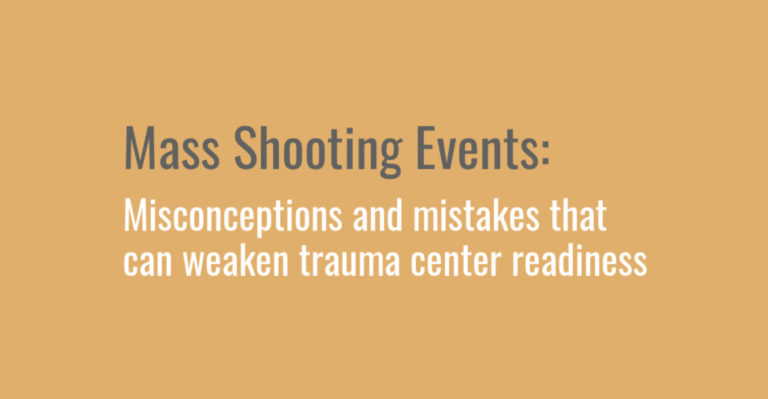Over the last decade, trauma centers have stepped up their efforts to prepare for mass shootings. But according to an expert in mass casualty response, there are several misconceptions about mass shooting events that can undercut hospital readiness.

“When you talk about disasters, you have to divide them into two types — progressive events and sudden events,” said Mauricio Lynn, MD, director of the surgical intensive care unit at University of Miami Hospital.
“With a progressive event like a hurricane, you have time to prepare,” Dr. Lynn said. “But with a sudden mass casualty incident like the Las Vegas shooting, the number of patients instantly exceeds the number of caregivers and there is not time to prepare.”
In many hospitals, mass shootings are covered under the “all hazards” disaster plan. According to Dr. Lynn, this is a mistake. He believes all trauma centers should have a separate mass shooting plan that is based on the unique epidemiology of mass shooting events.
The epidemiology of mass shooting events
In recent years, thousands of people worldwide have been killed or critically injured in large mass casualty incidents. Faced with these numbers, it is easy to lose sight of the fact that most victims of mass shooting events suffer relatively minor injuries.
“What we see in all mass shootings, all over the world, is that the percentage of critically injured patients is actually very low — a maximum of about 20%,” Dr. Lynn said.
Dr. Lynn is in charge of mass casualty readiness at Jackson Memorial Hospital in Miami. As former chief of trauma for the Israeli Defense Forces, he has helped plan and manage MCI responses in Israel and several other countries. He said the maximum critical injury ratio of approximately 20% holds true for all sudden MCIs, including mass shootings, bombings and earthquakes.
“What we see in the data is opposite of the common impression,” Dr. Lynn said. “In a mass shooting event, yes, you might have 200 injured patients, but maybe only 10% are critical. The rest are the walking wounded.”
Implications for mass shooting care philosophy
One of the basic concepts of mass casualty response is to do “the greatest good for the greatest number” of victims. This concept reflects the need to make the most of critical resources during an abrupt surge.
However, this principle is sometimes interpreted to mean that trauma centers should let the sickest patients go in order to focus on patients with serious but not life-threatening injuries. Dr. Lynn argues that this is a false choice.
“This ties back to the fact that in a sudden event like a mass shooting, very few people who make it to the hospital are critically ill,” he said. “If you can manage to find those few really sick people, the others can wait.”
The key, Dr. Lynn said, is to establish efficient and effective triage priorities. Triage should take place outside the ED, and it should be based on relatively few criteria:
- Respiratory distress
- Hemorrhagic shock
- Coma or altered mental status
- Amputation
“You do not need to get a blood pressure,” Dr. Lynn said. “If a mass shooting victim is in respiratory distress, is very cold, is unresponsive or has an amputation, he or she should be triaged as critical. You can find that out in less than a minute.”
According to Dr. Lynn, these critical patients should be treated first. In addition, trauma leaders should expect that only a small number of truly unsalvageable patients will arrive at the trauma center. “The predicted number of expectant patients after a conventional mass casualty incident is approximately 1% of the total number of patients arriving at the hospital.”(1)
Effective triage enables the trauma center to identify the 10% to 20% of mass shooting victims who really need care. “If you can concentrate your resources, you can save some lives,” Dr. Lynn said.
Implications for trauma center surge capacity
“About 10 years ago, the U.S. House of Representatives issued a report on hospital preparedness for a large terrorist attack the scale of the Madrid train bombings,” Dr. Lynn said.
The report was based on a survey of Level I trauma centers in seven major cities. The authors concluded: “[N]one of the hospitals surveyed in the seven cities had sufficient emergency care capacity to respond to an attack generating the number of casualties that occurred in Madrid.”(2)
The problem with this report, Dr. Lynn said, is that it equates trauma center readiness with ED bed capacity.
“No hospital in the world has 200 or 300 beds available in the ED to care for victims of a sudden event,” he said. “But again, the number of critically injured patients is actually very low. If you use triage to find the truly sick patients, you will be able to manage them.”
Dr. Lynn discussed bed capacity and injury distribution patterns in Mass Casualty Incidents: The Nuts and Bolts of Preparedness and Response for Acute Disasters.(3) Two key points:
- Assume that the maximum number of patients that can be managed abruptly in any given trauma center is approximately 20% of the hospital’s bed capacity.
- Recognize that following a mass shooting, the expected distribution of victims by severity will be approximately 20% severely injured, 30% moderately injured and 50% mildly injured.
Based on these principles, a 700-bed hospital should be able to accommodate a surge of 140 patients following a mass shooting or other sudden MCI. Of these patients, only about 30 will be severely injured.
ED beds will fill up quickly with these severely injured patients. However, the majority of moderately and minimally injured victims can easily be accommodated by maintaining an emergency supply of inexpensive stretchers.
“This is a concept developed in Israel that has been implemented in several hospitals,” Dr. Lynn said. “Store these stretchers near the ED. In the event of a surge, you can use them to transform open spaces such as a cafeteria or an auditorium into treatment spaces.”
Common mistakes following mass shootings
According to Dr. Lynn, the conventional wisdom on mass shooting contains several mistakes. For example, many hospital MCI plans specify that victims should be distributed throughout the care facility.
“The problem with this idea is that if you spread the sick out among different areas in the hospital, you will also have to spread out your specialized resources,” Dr. Lynn said.
Instead, trauma centers should centralize shooting victims as much as possible, with appropriate concentration areas for different severity groups.
“It is much better to organize these patients and keep them together in one place,” Dr. Lynn said. “That lets you concentrate your trauma nurses and critical care nurses.”
Another common practice is to accept staff from other hospitals, nurses who want to help out following a sudden MCI. Dr. Lynn discourages this practice.
“Everyone works best when they are on their ‘home field.’ So when nurses suddenly show up to help in a hospital where they have never worked before, it usually does not work out well. They don’t know where supplies are, they don’t know where equipment is, they don’t know the logistics of your hospital,” he said. “In my opinion, their presence increases the problems.”
Dr. Lynn also questions whether a centralized Hospital Emergency Incident Command System (HEICS) can be effective during the acute phase of a mass shooting response.
“The HEICS takes time to set up, and it is really for a disaster situation that unfolds over a number of weeks or even months,” he said. “But in a mass shooting or other sudden MCI, what you really need during the first few hours is simply to make sure you have enough staff.”
Instead of activating the HEICS, the first priority is to engage the administrator on call. “This individual will serve as the command system to bring in staff and also make reserve supplies available,” Dr. Lynn said. “He or she should give you the things you need immediately and that’s it.”
Learn more about preparing for a mass shooting
Dr. Lynn will talk about trauma center preparedness during the Florida Association for Critical Care Education (FLACCE) 2020 Annual Conference, which will take place virtually on November 14 and 15.
His presentation is entitled “Breaking the Myths of Readiness for Mass Shooting”. To learn more and register to attend this virtual event, visit the FLACCE website.
References
1. Lynn M, Gurr D, Memon A, Kaliff J. Management of Conventional Mass Casualty Incidents: Ten Commandments for Hospital Planning. Journal of Burn Care & Research. 2006;27(5):649-658.
2. United States House of Representatives Committee on Oversight and Government Reform. Hospital Emergency Surge Capacity: Not Ready for the “Predictable Surprise”; May 2008.
3. Lynn M. Mass Casualty Incidents: The Nuts and Bolts of Preparedness and Response for Acute Disasters. New York, NY: Springer; 2016.

